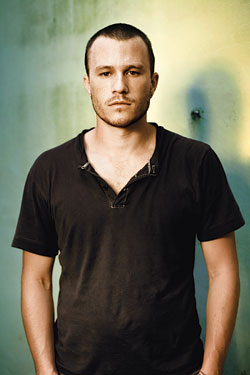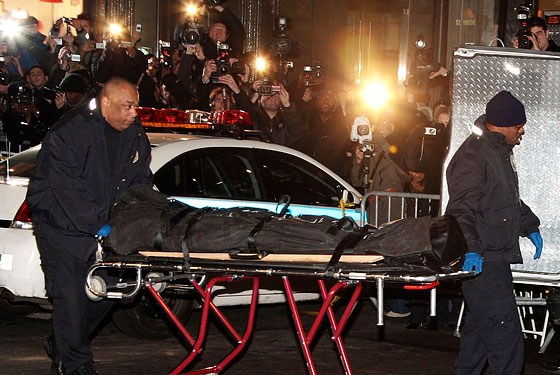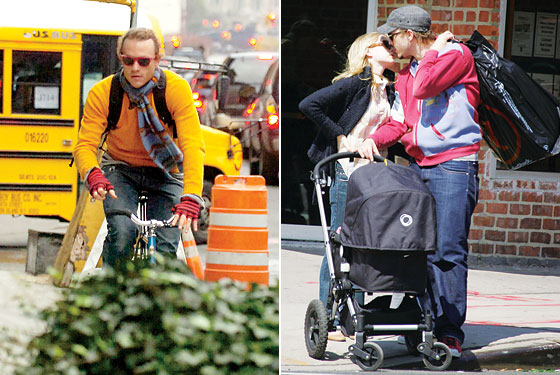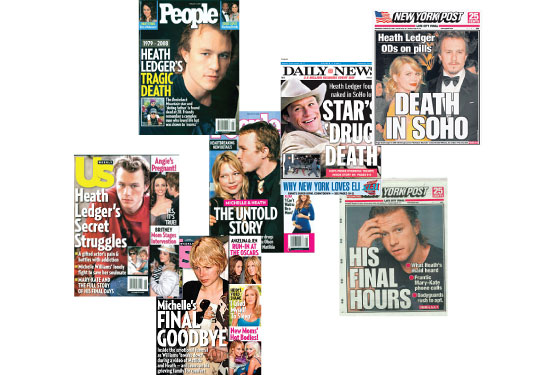
By Tuesday afternoon, we knew all about Heath Ledger. He’d been found in Mary-Kate Olsen’s apartment, naked on the floor, wreathed in pills, dead of apparent suicide. By Tuesday evening, he’d been found under the covers, in his own home, with the pills prescribed and in bottles. By Wednesday, he’d been alive until at least noon, when the maid heard him snoring. The masseuse who found him called Olsen once—no, three times—before dialing 911. Olsen’s bodyguards arrived before the EMTs. No, they arrived before the cops. A rolled-up $20 with drugs on it was by the bed. No, the bill was clean.
The sad, surreal story of Heath Ledger’s death was being written in real time, on a 24-hour news cycle, with digital cameras and RSS feeds. Television-news crews, online videographers, and cell-phone “citizen journalists” were participating in a dreamlike spectacle that was in its way more grotesque than the Hollywood Babylon tableau in Ledger’s apartment: Nearly 300 strangers on Broome Street, filming the removal of a body bag. One hundred more outside an Upper East Side funeral home, a scrum of cameras around a wooden box—all looking straight at each other.
According to Google News, there were 24,267 stories about Heath Ledger in the three weeks following his death. But for all the intensive coverage, there was no cohesive narrative. Two diverging accounts of his last months in New York were vying against each other—Ledger the saint and Ledger the sinner. An inconclusive autopsy allowed the conflicting reports to fester for weeks, with members of each contingent trotting out their theories and prophesying the results of the coming toxicology report that would surely prove them right.
“Don’t write one of these disgusting stories,” a Hollywood agent had warned me, after attesting to Ledger’s kindness, beauty, sensitivity, humility, and sobriety. A non-disgusting story would presumably reflect the innumerable accounts I heard of Ledger’s sweet nature, his immense talent, his love of Matilda—and make frequent mentions of Pellegrino water and Diet Coke.
A disgusting story would be like the one published by the U.K. tabloid the Sun the day after Ledger’s death, quoting Rebecca White, a 33-year-old former assistant to Naomi Campbell who claimed to have seen Ledger doing drugs. “The first time I met him, at Puff Daddy’s house in Los Angeles, Heath asked Naomi for cocaine,” she said. “At another party in Paris, Heath took at least six Ecstasy pills, popped them in his mouth all at once, and swigged them with a bottle of Champagne.”
As it happens, White, who was also a key witness to Kate Moss’s drug use when a video of the model snorting cocaine surfaced in 2005, seems to be the source for many accounts of Ledger’s Bunyanesque consumption. Her interview with the Sun was picked up by the Australian Daily Telegraph and Courier Mail and other papers. Then, in an interview with England’s Daily Mail, White elaborated, claiming that Ledger’s drug use had recently spiraled out of control because he was afraid of losing custody of his daughter and adding this striking comment about Ledger’s former fiancée, Michelle Williams: “Heath was an Adonis and she was dowdy and not in his league—career-wise or looks-wise—and no one could understand why they got together.” That version of the story was picked up by dozens of other publications, not to mention those to which she spoke anonymously as a “member of Ledger’s entourage.” She also offered to provide information to New York for a stipulated fee of $1,500 (an offer that was declined).
Whatever the sources—“friends,” “clubgoers,” “insiders”—such stories were spreading as fast as Ledger’s publicist Mara Buxbaum could deny them. By the last week in January, it seemed that there had been two Heath Ledgers living in New York. One, a chaste, sober, unkempt choirboy who bought his daughter organic breakfast sausages at the Gourmet Garage. The other, a womanizing, drug-hoovering rake last seen by, yes, “a clubgoer,” dancing at the Beatrice Inn “in a ski mask with holes cut out at the eyes and mouth and a hood over his head.” The debate over his last few months was about his legacy, about which kind of fallen star he would be: tragic hero (James Dean) or self-destructive burnout (River Phoenix). More than that, it was about what kind of person he was—loving or noncommittal, open or secretive, good father or careless lout, true or false. His cause of death, it seemed, would somehow define the meaning of his life.
Strolling down Smith Street with Michelle and baby Matilda, Ledger had been the most attractive advertisement that young, urban parenthood had had in years: a stubbly boho in lank hair, cord jacket, and scruffy boots; a member of the neighborhood-preservation committee; a doting father who brought Matilda to Book Court and Bar Tabac and made his only tabloid appearances in Us Weekly’s “Just Like Us” section, as another happy, semi-washed stay-at-home dad. “I didn’t want to raise my child in Hollywood,” he had said. And so it seemed that the preternaturally wise 26-year-old had discerned the exact spiritual and geographic antipode to the Viper Room: a brownstone in Boerum Hill.

Indie sweethearts Ledger and Williams had met in the summer of 2004 on the set of Brokeback Mountain. Like many young actors, Ledger had a history of falling in love on set. He had met former girlfriend Heather Graham in Prague, while he was filming A Knight’s Tale and she was filming From Hell in 2000. He had fallen for fellow Aussie Naomi Watts when they were both making the Australian film Ned Kelly in 2002. He and Watts were together for nearly two years but split just before Brokeback—a film she had encouraged him to make—because Watts, eleven years his senior, reportedly wanted a family, and Ledger, then 24, wasn’t ready.
Less than a year later and just a few months into a new relationship, Ledger was a father-to-be. He and Williams hadn’t planned the pregnancy, but in 2006, he told Rolling Stone that the event was practically fated: “We just fell very deeply into one another’s arms. Our bodies definitely made those decisions for us.’’
Matilda was born on October 28, 2005, and the young parents presented as delighted domestic partners. “I’m Mr. Mom,” he told the Boston Globe. “I get [Michelle] granola and cook her an egg, I clean the dishes, and then I’m cooking lunch … I love my new job.”
Two months after Matilda’s birth, Brokeback Mountain was released to raves and Oscar nominations, starting the decades-old chain reaction that would make Ledger into something other than a talented actor. The transition was subtle, marked by debuts on magazine covers, increased paparazzi, online chatter, buzz, spin, and hype, but at a certain point, it was a fact: Ledger was a star.
“The star phenomenon consists of everything that is publicly available about stars,” wrote the film theorist Richard Dyer in 1986—decades before this came to include sex tapes, iPhone hacks, abs reportage, plastic-surgery critique, and that clearinghouse for witless, bitchy speculation, the “Comments” sections of blogs. A probing and adventurous character actor—someone who said he had purposely “taken the blonde out of his career” by choosing roles like a suicidal prison guard in Monster’s Ball—Ledger had now been cast as Heath: happy father to Matilda, committed life partner to Michelle, gracious newcomer to worldwide fame.
Ledger clearly hated this kind of attention. He had already been battling it out with the Australian press, which, at the Brokeback premiere in Sydney, shot him and Williams with water guns as they walked the red carpet. Ledger was reportedly in tears when he talked to his father later that night, saying he was going to sell his house in Sydney and make a permanent move to the States. Two weeks later, he was at the Screen Actor’s Guild Awards in Los Angeles. The red carpet went off without a hitch that night; it was the after-party that would later prove problematic. This was the night when the recently surfaced video of Ledger allegedly doing coke was shot.
The video—called “shocking” and “harrowing” in the press—was first acquired by Australia’s Channel 9 and later won its provider $200,000 from the TV show The Insider, but was quashed after Ledger’s publicist rallied some high-profile Hollywood troops (Natalie Portman, Sarah Jessica Parker, Josh Brolin) to threaten a boycott of the show. For such a reputed smoking gun, the clip shows little more than a party that any young urban American would recognize. Ledger swigs from a beer bottle, says he’s going to get serious shit from his girlfriend upstairs for being at this party, admits to formerly smoking five joints a day, and points to his tattoo of “M” (for then-3-month-old Matilda), saying, “This is to remind me never to smoke weed again.” The biggest surprise is the oddly solicitous and self-deprecating manner of the award-nominee.
From all accounts, the context of the video was not raucous celebration but growing unease. “He was in a terribly anxious state during the Oscars,” recalls an English film director who spent time with Ledger at the Château Marmont waiting out award-season mania. “The day after the Oscars, he said to me, ‘I’ll never make another good film again.’ If this was what happened when you made a good film, he didn’t think it was worth it. He found the whole thing absolutely harrowing. I think that after the Oscars, there was a kind of corner turned—and not a very good one.”
That was around the time that Williams allegedly tried to take Ledger to Promises rehab center in Malibu, according to Us Weekly (a story Buxbaum says is fabricated).
Sometime that summer, as the pressures grew in Los Angeles, Ledger and Williams took up permanent residence in Brooklyn. This began a kind of Camelot period that was savored as much by neighbors and local media as it was by the family itself. “It’s the closest we’ve ever come to feeling like we can lead a normal life,” Ledger told this magazine. “We’ve localized ourselves. I don’t think there’s another place on earth I’d rather be right now. We’re very happy.”

By most accounts they were. Todd Haynes, who directed Ledger and Williams in the Bob Dylan reverie I’m Not There, remembers how the actor would lean on his fiancée when they were shooting in late summer 2006. “The night before we were going to shoot a scene, he started to have a real panic about it,” says Haynes. “He had to call Michelle in New York, who talked him through relaxation methods to try to get him asleep. He said he was just curled up in a corner holding one of Matilda’s stuffed animals, and he slept about an hour and came on set.”
A little over a year later, it was over. Ledger moved out of their moss-green townhouse in Boerum Hill. Friends would tell the press he and Williams had grown apart, that they were struggling with the demands of parenthood and two full film careers. Unattributeds would talk about drugs and a custody battle. Williams laid low, taking Matilda with her on a head-clearing trip to an ashram in India. Meanwhile, the gossip pages started auditioning another Heath Ledger.
This one wasn’t Just Like Us. This one was a gorgeous Australian party boy in a trilby hat and tattered-chic cardigan—the fun- loving, most eligible recent bachelor in New York, linked to models like Helena Christiansen, starlets like Lindsay Lohan, and finally Mary-Kate Olsen—to whom he was linked only posthumously. This Ledger lived for three months.
The first weekend after the unfortuitously named Celebrity Moving van transported his things from the Boerum Hill brownstone to the Broome Street loft, Ledger went to the Beatrice Inn, the semi-private club in the West Village where one could regularly spot Owen Wilson, Kate Moss, Kirsten Dunst, and other members of the hip-celeb demimonde. Even in this crowd, Ledger stood out.
“Girls were all over him, trying to, like, play with his hat, touch him in some way,” says a woman who met him that night. “Certain celebrities have that effect. I’ve only seen it with a few of them, and Heath Ledger is one. The reaction I saw to him was … crazy.” She remembers Ledger wearing a red-and-white horizontal-striped shirt, jeans, a hat, and a few visible tattoos. “He was really hot,” she says, allowing for the teenybopper reaction he provoked among the club’s typically more composed habitués.
“The day after the Oscars, he said to me, ‘I’ll never make another good film again.’ If this was what happened when you made a good film, he didn’t think it was worth it.”
As Ledger parried advances on the dance floor, his companion, a man named Nathan, reached out to the young woman and her friend. “He introduced us to Heath. He was really nice, shook our hands, said, ‘Hi, my name is Heath.’ And a lot of celebrities don’t even say their names because they expect you to know who they are. He wasn’t like that,” she says. Nathan asked the girls to type their numbers into his cell phone if they wanted to hang out later. “We were sure he wasn’t going to call.” But as they were leaving the club, Nathan chased them outside to give them the address of Ledger’s new loft. “I didn’t realize he was being so covert, that we couldn’t be seen leaving with him because it was right after the breakup and the press was all over him about Helena Christensen.” (Despite the discretion of Ledger’s wingman, the exchange wound up in the Post a few days later.)
“We went over and hung out, played backgammon,” she says. “I said something like ‘Great apartment.’ And he said, ‘I just moved in four days ago.’ ” She remembers Ledger’s home in a state of luxurious flux. “He had a red velvet couch, a really nice carpet,” she says. “There was some exercise stuff, a Mac computer. He was like, ‘I want to play this music for you,’ but his Internet wasn’t up yet.”
The Ledger she met was quiet, friendly, and pointedly sober, drinking Diet Coke as the rest of them had red wine. He mentioned having to be up at ten the next morning to take his daughter to gymnastics. Someone had drugs that night, but Ledger’s friend kept them away from him. “Nathan said, ‘Heath can’t see this.’ He was making an effort to protect him, and Heath was obviously in a vulnerable state. He said, ‘Heath cannot see this stuff, he had problems, he’s sober now.’ He was a really good friend actually, now that I look back on everything.”
The two had a monthlong fling—a brief intersection between celebrity and civilian worlds. (Though it didn’t start that night: “Just because you’re so-and-so doesn’t mean I’m going to sleep with you,” she told him. “No, I’m not, I’m a nice guy,” he protested.) “He didn’t like being this star,” she says. “This is from my experience of him. He was kind of quiet unless he was comfortable … It was just after the breakup, and it really seemed like he was just trying to have fun.”

In the time they spent together, from late September through mid-November, the woman never saw Ledger do drugs. “He had a party at his loft once, and it was really crazy. There were drugs there, but he didn’t touch them. I saw it offered to him multiple times. Ecstasy, cocaine, even prescription stuff—but he never touched it. I was with him at least a dozen times, and he was always sober. Just cigarettes.”
Ledger’s death has given anecdotes like this one—along with contradictory stories about, say, wild man Ledger snorting piles of coke and downing every bottle in the hotel minibar—a new intensity. And a price tag: The woman from the Beatrice Inn says a tabloid offered her up to $5,000 for dirt on Mary-Kate or Heath’s drug use. (She declined to sell her story.)
Every sighting has been analyzed posthumously for clues to his sobriety and state of mind. Joseph Ari Aloi, the friend and tattoo artist who had inked a red M for Matilda on Ledger’s chest, thought Ledger may have been stressed right before Christmas: “When you’re the kind of guy that has to be creating and documenting and expressing all the time, it’s hard sometimes to be horizontal and dormant. He had a really hard time turning it off.”
A director friend who spoke with him by telephone in January said that people had been worried about him. “The thing I feel worst about is that because I was a little bit in awe, and didn’t want to lose him as somebody I could talk to, I didn’t say what was on my mind,” he says. “I think that’s another way that famous people isolate themselves is that sometimes people find it very difficult to say, ‘You’re killing yourself.’ ”
Christopher Plummer, who was working with Ledger on the set of Terry Gilliam’s The Imaginarium of Doctor Parnassus, told reporters that Ledger was in such bad shape he appeared to have walking pneumonia.
“Of course there’s going to be a stampede to understand him—even understand literally how he died,” says Todd Haynes. “I think people just want some concrete explanation. I think we’re grappling for something. What’s so hard about this is that there is not a real character arc—arguably, there never is, no matter how long someone lives. But this one was so full of promise and so in bloom that it feels just savage to have it be foreshortened so brutally. That’s what makes it so intolerable to the public, which makes the search for more clues so intense.”
One clue, offered by the Los Angeles Times as evidence of the actor’s downward spiral, was a clip from an interview with Ledger in December about his role in I’m Not There. The interviewer claimed Ledger “was clearly slurring and unfocused,” but viewers would find a video of a disappointingly lucid Ledger, discussing his view that biopics run the risk of defaming their subject: “Because you’re assuming too much. I think this movie avoids it gracefully by not assuming to know who Bob Dylan is. He’s kept in the shadow … It’s preserving his mystique.”
When Haynes met Ledger in 2006, the actor was already struggling with similar questions about the art of biography, having taken a two-year sabbatical from acting to write a script about the life of singer-songwriter Nick Drake. “Trying to squeeze this complex, beautiful, and mysterious subject into the confines of the traditional biopic he found reprehensible and kind of cruel,” says Haynes. “He was starting to approach it through a more allegorical method, where it was going to be about a woman traveling on a train ride through Europe—which Nick Drake I think did do—and he was going to have Michelle play that role.” Now, the idea that Ledger had spent two years trying to get inside the head of an artist who suffered from depression and insomnia and died at 26 from an overdose of a prescribed antidepressant has become one more detail to be used as either tragic irony or psychoanalytic insight.
The fact is, Ledger probably did cocaine. He might have snorted, smoked, or even injected heroin (in his glam-hipster milieu hardly the gutter death-trip many assume), although he convincingly denied it when describing preparations for his junkie role in Candy. He certainly took prescription pills, possibly not always for medical reasons. And as he said, he used to smoke several joints a day.
But contrary to the binary thinking of the media’s Ledger debate, his drug use doesn’t negate the “good Heath” story line. The arbitrary distinctions between good and bad drugs, and good and bad star behavior, obscure the fact that there likely was no bad Heath Ledger. As it happens, he might have been better off if he had behaved more horribly, if he weren’t so widely adored. An addict’s best hope for recovery is being an intolerable asshole when he’s using. And to say the least, few remember that kind of Ledger.
“You knew he was special when you met him, both as a person and as an actor,” says a producer who worked with him on Brokeback. “Literally, everybody loved him.” Partly it was his bravery in taking on the role of gruff, repressed gay cowboy Ennis Del Mar. (“People forget what an incredibly bold move it was to play that character,” says the producer.) Partly it was the impression he gave of being, in Haynes’s words, “a real seeker and a real explorer,” still trying on different identities. Partly it was his behavior on set, where he steered clear of chauffeurs and trailers, preferred skateboards to SUVs, and worked alongside the crew between setups. And partly it was his rejection of the trappings and attention of Hollywood, his attempt to live an ordinary artist’s life.
“There’s something about Heath,” says Haynes. “We somehow figured, through his work and the ways people saw him, that he was above and beyond this kind of an end.”
Strangely enough, considering the number of paparazzi and “friends” and bartenders and cell-phone-camera users in the city, there is no accurate account of Ledger’s final 24 hours. He was last seen at the Beatrice Inn the Sunday before he died, wearing, in either a misguided bid for anonymity or a sign of serious psychic trouble, a ski mask over his face.
Ledger didn’t hide his insomnia, stress, or poor health. He was on a break from shooting The Imaginarium on cold, wet outdoor London sets. He was flying back and forth to New York, flipping time zones, missing his daughter, going into his usual creative hyperdrive, and wandering the city into the early hours. On the night before he died, he may have been suffering from any combination of depression, anxiety, insomnia, pneumonia, drug addiction, and/or drug withdrawal. The only thing for sure is he was doing it alone.
On February 6, just three days before Ledger’s body would be cremated, the putative epilogue to this story was delivered by the office of New York’s chief medical examiner: “Mr. Heath Ledger died as the result of acute intoxication by the combined effects of oxycodone, hydrocodone, diazepam, temazepam, alprazolam, and doxylamine. We have concluded that the manner of death is accident, resulting from the abuse of prescription medications.”
As a final chapter, this reads like William Burroughs doing Lewis Carroll, its logic confoundingly circular. Xanax, Valium, Unisom, Restoril, Vicodin, OxyContin—two downers, two sleeping pills, and two painkillers of a caliber used for bone cancer. This would indeed make one acutely intoxicated. And if one died, one would indeed have died of acute intoxication. It was an accident, certainly, but in the same way that driving drunk off a pier would be an accident. Or ODing on heroin.
Ledger’s parents cited the pharmaceutical provenance of the drugs as proof that their son was the victim of a simple prescription-drug mix-up. “Today’s results put an end to speculation,” they wrote in a statement. “While no medications were taken in excess, we learned today the combination of doctor-prescribed drugs proved lethal for our boy.”
In the end, Heath Ledger’s official cause of death was a toxicological character sketch—masterfully vague, all facts with few answers. Much like his life, we could read it any way we wanted.